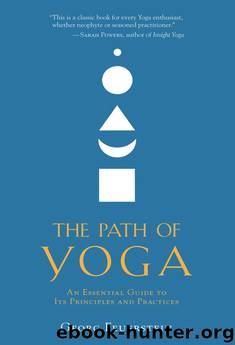The Path of Yoga by Georg Feuerstein

Author:Georg Feuerstein
Language: eng
Format: epub
Publisher: Shambhala
9
Sacred Sounds of Power: Mantras
He who utters the single syllable AUM, remembering Me when he departs [from this life], abandoning the body—he goes to the highest goal.
—BHAGAVAD-GITA VIII.13
Mantra-Yoga: Unification through Sound
One of the most remarkable discoveries of the ancient Indian sages was the insight—undoubtedly based on their mystical experiences—that the universe is an ocean of vibration (spanda). This idea was developed particularly by the philosophers of the various schools of Shaivism current in Kashmir. They also taught that vibration, or pulsation, characterizes not only the manifest world but also the Absolute, Shiva, itself. For them, the divine Reality or Being is continuously self-transforming while paradoxically at the same time transcending all movement.
This idea, like most philosophical or psychological notions of the Yoga tradition, arose as a result of personal mystical experience rather than mere intellectual speculation. In modern terms, the universal pulsation of the Absolute can be understood as a “holomovement,” to use a term coined by the British theoretical physicist David Bohm. Such a movement is incomprehensible, as it does not represent mere motion in space-time. Hence most Yoga schools prefer to speak of the immovable and unchanging nature of the Divine.
Kashmir’s Shaivism received a great boost among Western students through the teaching of Swami Muktananda, who attracted a large following in the 1970s and 1980s. His Siddha-Yoga is built on the theoretical foundations of the Shaiva tradition of that Himalayan country.
Understanding the vibratory nature of conditional existence is fundamental to mantric science (mantra-vidya), the esoteric discipline employing sound as a means of spiritual transformation and transcendence. This spiritual approach is also known as Mantra-Yoga. According to this yogic school, all perceptible sounds ultimately derive from the universal matrix of sound known as the shabda-brahman. This expression can be translated as “sonic Absolute.” The sonic Absolute is the eternal Word embodied, for instance, in the sacred utterances of the Vedic seers and preserved down to our own time as the four Vedas. The quintessence of the Vedic revelation is the sacred monosyllable OM, which forever reverberates in the depths of the human heart and the cosmos. I will say more about it later in this chapter.
The Maitri-Upanishad (VI.22), a work of the pre-Christian era, declares that the sonic Absolute can be heard as the sacred sound OM in deep meditation. This subtle sound is also called nada, which is said to be “unstruck” (anahata) or uncaused. Beyond the sonic Absolute there is the nonsonic (ashabda) and wholly transcendental Absolute or para-brahman. By contemplating the sonic Absolute, which is the lower of the two modalities of the brahman, the yogins are said to reach the higher Absolute beyond all sound, the vibratory (living) Reality beyond all vibration.
Mantra-Yoga is the path leading to the undifferentiated Absolute through the vehicle of sonic vibration. It aims at unifying consciousness through the recitation and contemplation of specially empowered or numinous sounds called mantras. While mantras are almost universally employed by the various traditions of the Indian peninsula, Mantra-Yoga uses this particular technique as its principal method.
Download
This site does not store any files on its server. We only index and link to content provided by other sites. Please contact the content providers to delete copyright contents if any and email us, we'll remove relevant links or contents immediately.
Periodization Training for Sports by Tudor Bompa(8170)
Bodyweight Strength Training by Jay Cardiello(7841)
Born to Run: by Christopher McDougall(7065)
Inner Engineering: A Yogi's Guide to Joy by Sadhguru(6725)
Asking the Right Questions: A Guide to Critical Thinking by M. Neil Browne & Stuart M. Keeley(5635)
The Fat Loss Plan by Joe Wicks(4847)
Bodyweight Strength Training Anatomy by Bret Contreras(4612)
Yoga Anatomy by Kaminoff Leslie(4306)
Dynamic Alignment Through Imagery by Eric Franklin(4118)
Science and Development of Muscle Hypertrophy by Brad Schoenfeld(4089)
ACSM's Complete Guide to Fitness & Health by ACSM(3989)
Exercise Technique Manual for Resistance Training by National Strength & Conditioning Association(3956)
The Four-Pack Revolution by Chael Sonnen & Ryan Parsons(3932)
Bodyweight Strength Training: 12 Weeks to Build Muscle and Burn Fat by Jay Cardiello(3915)
The Ultimate Bodybuilding Cookbook by Kendall Lou Schmidt(3886)
Yoga Anatomy by Leslie Kaminoff & Amy Matthews(3863)
American Kingpin by Nick Bilton(3757)
Nutrition for Sport, Exercise, and Health by Spano Marie & Kruskall Laura & Thomas D. Travis(3715)
Yoga Therapy by Mark Stephens(3703)
